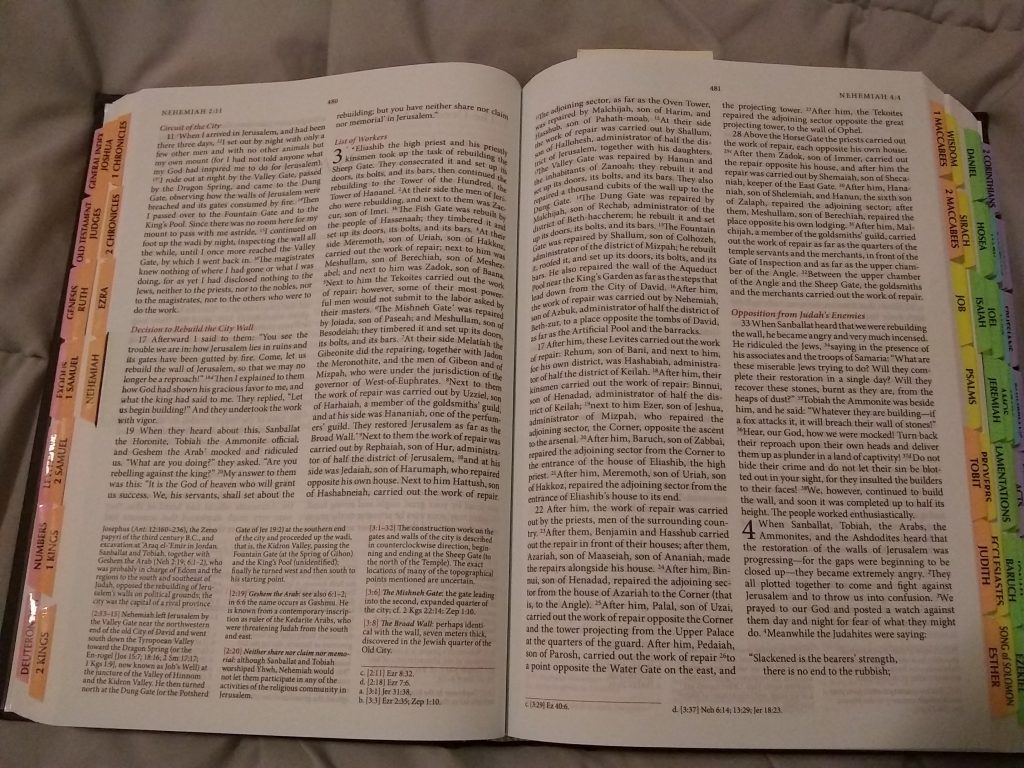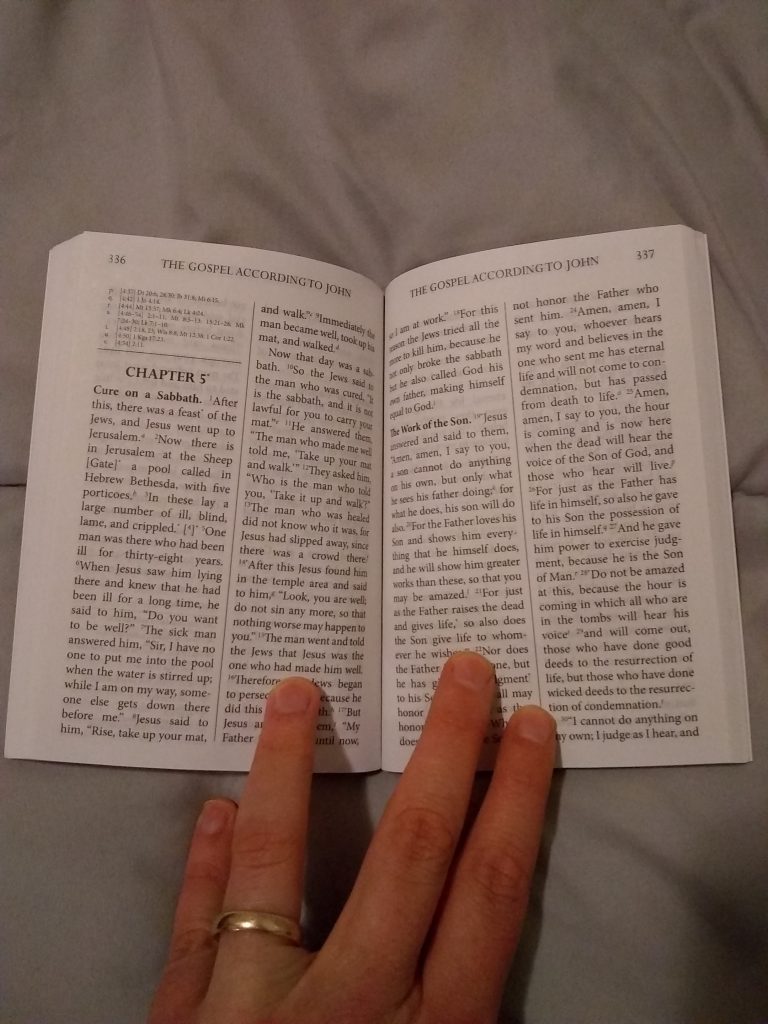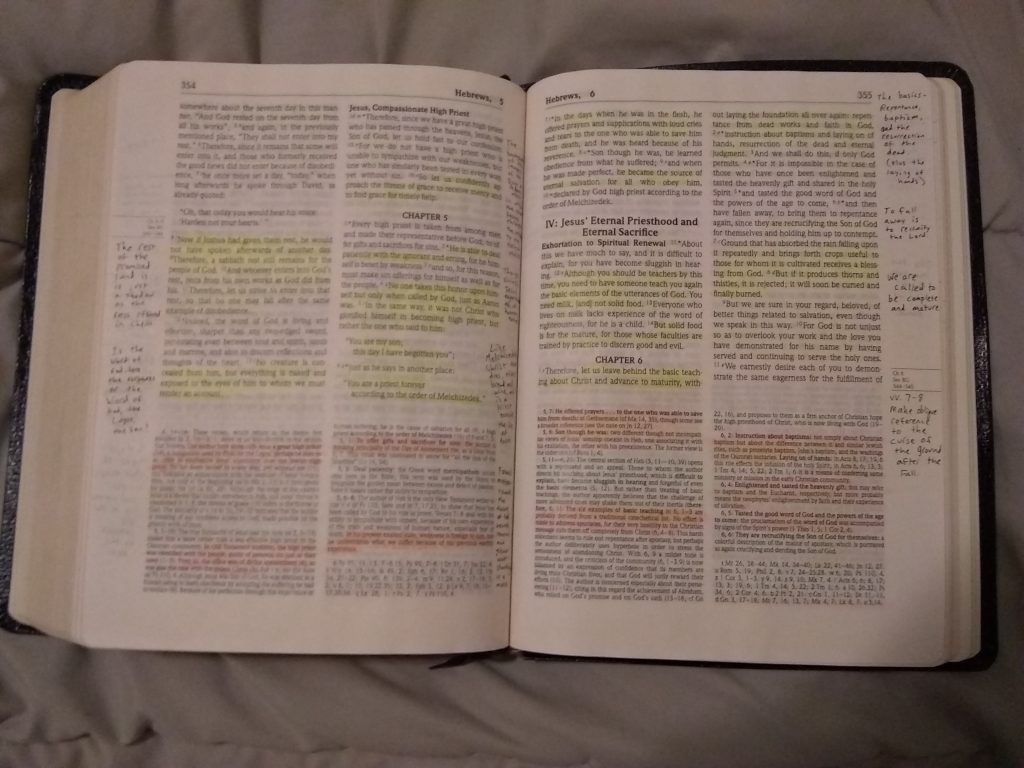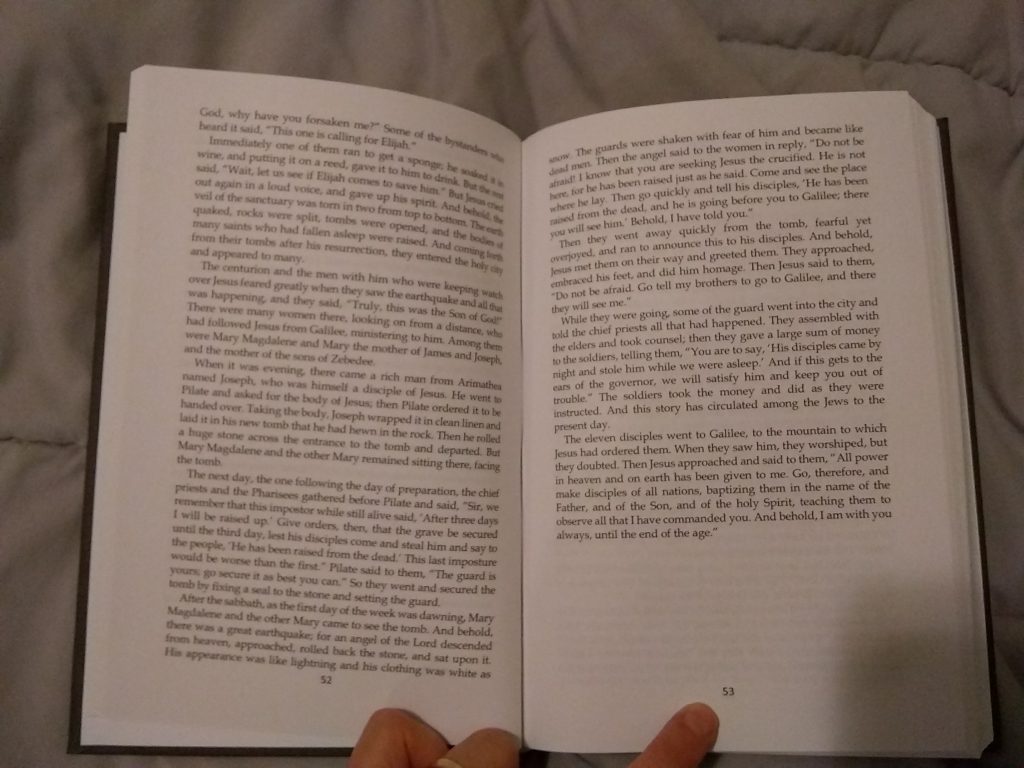Thanks to Marc for maintaining this blog!
Back on Timothy’s site, I wrote a couple of comparisons between the New American Bible and the Lectionary. It is a topic that interests me, firstly because I love hearing the readings proclaimed at Mass, but also because the New American Bible is my preferred translation.

Here is my Harper One NABRE which I’ve been reading this Lent. I read it in a little chair by a window as I drink seltzer and listen to Gesualdo. (It makes me feel very cultured.) My spiritual director suggested I try to read through as much of the Old Testament as I can manage. I began with the Knox, but by the time I was done with Judges the NAB was calling my name! As I write this I am now in Nehemiah. It has been fun to encounter lots of scripture we never encounter in the daily readings. Some sections I’d never read before. (Check out 2 Chronicles chapter 30 if you’ve never gone that deep into the historical books.) In my mind, this is the best NABRE page design I’ve seen. The footnotes are in smaller type and arranged in three columns. This sets them apart from the text, reducing their distraction to the distractible reader. Before 2011 all NAB editions tended to look the same on the page, and the footnotes could be a huge distraction, especially in the Pentateuch and the Gospels, where the notes were plentiful.

Here is a pocket copy of the NAB Gospels and Acts that the USCCB put out that I’ve been keeping by my bed. I enjoy reading while lying on my side, and this little book is very helpful for the wrist! The notes are exiled to the end of each book, which makes for a cleaner read. Some other editions of the NAB that put the notes at the end of books are the Pauline NT and Psalms combo, the old pocket New Testaments from Catholic Book Publishing (out of print, I think, but common in the secondary market), and Oxford editions. Speaking of Oxford, in my mind their old Reader’s Editions of the NAB and RSV-CE were the perfect sized bible. Others must agree, because used copies are unspeakably expensive online. I also would not complain if they made available a compact hardcover of the NABRE to match the RSV-CE they sell.

Here’s the 1st edition Catholic Study Bible that I have marked up a bit as I’ve worked through the New Testament epistles in the New Collegeville commentary series. I found it for 15 dollars a few years back. It seems to have the widest margins of any Catholic study bible I’ve come across. The notes have gotten better with each of the three editions, I think, but in terms of design it never got better than this!

But here is what I use when I pray with scripture. It is something I made myself for my own private use. I copied and pasted the NAB New Testament text into a Word document, eliminated all the verse markings, notes, headings, and cross references. I also eliminated the brackets around some sections and made some snap textual decisions when the NAB printed both options and left it to the reader. (Such as in John 6:1, which reads, “After this, Jesus went across the Sea of Galilee [of Tiberias]”.) The photo is the last two pages of St. Matthew’s gospel. I also made a copy of the Psalter in this style. My design choices were inspired by the old blue hardcover editions of the New English Bible, in all their musty, paraphrased, single-columned glory.
So many editions of the same translation! (Does anyone else do something similar with their own favored translation? Write it in the comments!)
Another revision of the NAB is expected in 2025—by my count the 5th version to come out under the name “New American Bible”. The revisers’ stated aim is to create a version which can be used for “individual prayer, catechesis, and liturgy.”
A bible that matches our lectionary! That has been a fantasy of mine for quite some time. In the UK they have the CTS Bible, but nothing of the sort exists in America, though the NAB edition in print from 1986 and 1990 comes extremely close.
In previous comparisons, I have noted that the 2011 NABRE OT isn’t all that different from the 1970 NAB OT, but that the changes it makes are definitely in the direction of formal equivalence. As for the lectionary, it only lightly edited in the 1970 OT and 1986 NT of the NAB text.
Will an analysis of the lectionary texts of the Triduum lead to the same conclusion? It is when our parishes draw closest to the mysteries of the faith—Lent and Advent—that we see the Old and New Testaments coincide in the mysterious and luminous ways. A recurring complaint about the modern translations as that they wreak havoc with Old Testament typology by approaching the Hebrew canon from a scientific, literal perspective. Will we see large differences between the 1970/1986 NAB text and what we participate in this holiest of seasons?
Stand by for text comparisons for Maundy Thursday, Good Friday, Holy Saturday and Easter.
May God bless you. May your time with scripture be fruitful.
“In previous comparisons, I have noted that the 2011 NABRE OT isn’t all that different from the 1970 NAB OT, but that the changes it makes are definitely in the direction of formal equivalence. ”
Good article, but I wanted to comment on this.
As far as it goes, there aren’t going to be many significant differences between any two translations chosen at random because there is usually only one way to express a particular thought in English, the only difference between two renderings is going to be the order of words or the use of synonyms.
If you take 5 people, give them a passage to translate (say the Gettysburg Address) from English to Spanish, and don’t let any of them see the other’s work., the translations will be at least 90% identical. And not because anyone is copying anyone else’s work.
So, sure, there is not much difference, there is never going to be that much difference.
But, if you can find a list of all the problematic passages in the 1970 NAB OT and compare them to the 2011, more than 90% of the time, you will find that the 2011 fixes the problem. Example: Psalm 23.
That is very true about the limited way to say something in the English language.
The NABRE changes are quite welcome and have improved the translation, but in many areas the revisers were content to leave the text as it stood. The notes remain the same in some areas as well. These are not bad things. I think they started with a very good rendering and improved it.
The psalms are a different category though. I’ve never sat down and compared the different NABRE psalms with previous editions, but it seems like a re-translation not just a revision. Maybe I’ll be surprised when I look, but that’s my preconceived notion.
Bob,
Good article, thanks! I don’t share your love for the NAB, yet your points are most welcome.
I like your idea of the “do it yourself” NAB NT. I had a somewhat similar project with the RSV-CE Gospel of John (I went to a local supply store, and had an 8×10 hardcover done). I’m trying to figure out how to do a smaller version (as it appears you’ve done). Another task to work on, nevertheless!
James
I printed my book using Lulu. Let me know if you need to be talked through it and I’d gladly tell you how I made that specific one!
Is the RSV your preferred translation?
Thank you for this interesting article. Also, special thanks for introducing me to Gesualdo. I have added him to my go to creators of sacred music. While hunting for Gesualdo the following recording of Palestrina’s work regarding the soon coming Holy Thursday celebration popped up on YouTube. This is an excellent production “Maundy Thursday Tenebrae: Palestrina” https://youtu.be/Iiu0kdsPG-s?t=577
For me the most attractive editions of the NABRE are the ones produced by American Bible Society. I have this used edition which has a ribbon and a blue cover, the pages are nice and crisp white and the way it rests with just the right dimensions is a great read. I’m curious with how it seems America has set the standard for translations in the Catholic biblical tradition with how advanced the NABRE is, it’s even more up-to-date than the NRSV. I think it’s funny how some conservatives show disdain towards the NABRE when the notes in it are “textual notes” NOT dogma or pastoral commentary. I find the translational choices interesting when compared with the NJB, such as Jacob’s “ladder” vs “stairs” or Leah’s eyes being “lovely” vs “dull”
Ultimately I think it’s important to consider the background of the translation, the NABRE has a very transparent list of editorial staff, revisers, and other contributors whereas the NJB is more a fusion of ecclesiastical and ecumenical translation effort focused on literary quality and rich English, the NABRE on the other hand seems more in line with being a Catholic translation with interfaith involvement focused on accessibility and varied use (prayer, study, proclamation).
I’ve always admired the NABRE with it’s biblical text and notes and it has always inspired me to deeply meditate on the Word of God, I’ve just been on the fence about what translation to use and a “main” Bible. I keep picking up the NJB since I see it as a more unique tradition from among the array of different Catholic versions to use, then I consider the NABRE for it’s notes and merits and I get stuck. The NJB is refreshing as it offers an experiences that uplifts the biblical rendering from the usual “Americana” that I hear or the Church politics of RSV vs NRSV – NAB vs RSV2CE and liturgy wars and so on.
I agree that people’s hangups with the NABRE cloud the fact that it makes the largest use of the LXX and DSS of any mainstream English translation, the 2021 NRSVue included. I have little doubt that the 2025 edition of/successor to the NABRE will probably be the most textually up-to-date English Bible on the market, making even the NRSVue seem outdated already in comparison. All the translation politics, etc., really causes internet Catholics to sleep on just how good the underlying textual scholarship is in the NABRE.
Excellent article, informative. Where exactly have they mentioned these details about the upcoming edition? I also wished that the name should be simplified to NAB by removing RE. I will have to postpone my plan to buy this until this latest edition arrives. The page design is the best and unique, but the study notes are the most scholarly in which they explain the WHY of every crucial thing with critical scholarship, whereas all the other study Bibles moves in circle with a dogmatic doctrinal approach without any literary and source criticism.
My request would be for them to render text translations literally rather than interpretatively, such as Gen 3:15 and 12:7 seed should be singular for the typological allusions to Christ. Rendering them plural hinders the typological quotation allusion. I have not read it but gender inclusive nonsense should be avoided by all cost. And the homosexuality verse should not be narrowed down to boy prostitution.